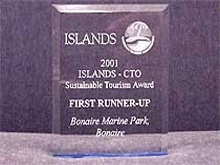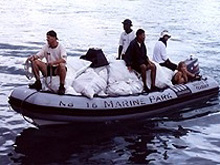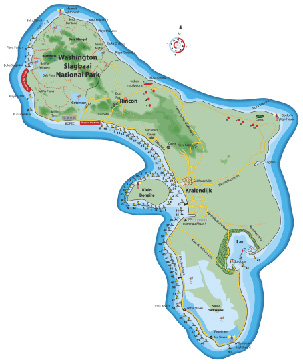Figure 1. In 2001, Bonaire was awarded the first runner-up award for sustainable tourism as a result of the marine policy in place and the implementation of diver fees to subsidize the maintenance of the park. Image courtesy of NOAA Bonaire 2008 expedition
Figure 2. Stichting Nationale Parken Nederlandse Antillean (STINAPA) rangers perform routine maintenance in the Bonaire National Marine Park, which entails the upkeep of more than 60 dive site markers, routinely check and replace the lines and buoys at over 100 public mooring sites. Rangers are currently undertaking the task of switching older, double-barrel moorings with a pin-type unit designed for mixed substrate. Image courtesy of NOAA Bonaire 2008 expedition.
Bonaire: A Model in Reef Sustainability
Noelle J. Relles
Graduate Fellow
Virginia Institute of Marine Science (VIMS), College of William & Mary
Mark Patterson
Expedition Leader
Associate Professor of Marine Science
Director, Autonomous Systems Laboratory
VIMS, College of William & Mary
Coral reefs offer a critical habitat in the marine environment, rivaled in biodiversity only by terrestrial rainforests. According to the National Center for Ecological Analysis and Synthesis at the University of California at Santa Barbara, coral reefs make up about 1% of the world's oceans, but they house nearly 25% of life in the ocean. The global trend toward increasing sea surface temperatures has led to a dramatic rise in coral bleaching incidents. Bleaching refers to the corals loss of symbiotic microalgae that provide fixed carbon for the coral polyps. The long-term sustainability of reefs is critical for the survival of marine invertebrates, tropical fish and larger organisms that utilize the reef as a habitat. Although the effects of global climate change in the world's oceans are difficult to mitigate on a regional scale, marine policy implementation and marine protected areas can be useful tools for helping to preserve the reef and its inhabitants.
A Marine Protected Area (MPA) is often used as an umbrella term covering a wide range of marine areas with some level of restriction to protect living, non-living, cultural, and/or historic resources. MPAs are often criticized as being "paper parks" due to lack of enforcement. Considered the most pristine reefs in the Caribbean, Bonaire sets an important precedent regarding marine protection policy (Figure 1). With early implementation and enforcement of the Bonaire Marine National Park (BMNP) in the 1970s, a comparison of the state of Bonaire's reefs over time could have important implications for future policy regarding the protection of marine resources in this and other areas.
Figure 3. This map of the island of Bonaire and Klein Bonaire shows the marine reserve areas of the leeward side (marked in red) along the coast. As opposed to the marine park, the marine reserve allows no water entry for snorkelers and divers whatsoever, and therefore these might be considered the most pristine areas on the island. Image courtesy of NOAA Bonaire 2008 expedition.
Bonaire has a long history of marine preservation, beginning with turtle protection in 1961, the prohibition of spear fishing in 1971, and protection for coral, dead or alive, in 1975. The waters surrounding the entire islands of Bonaire and Klein Bonaire are considered part of the BNMP, which has existed since 1979 and is protected by STINAPA (Figure 2). The small island of Klein Bonaire to the west of the main island was added to the BNMP in 2001. The funding for preservation of the BNMP is subsidized by mandatory dive tags, which can be purchased for US $25, and are required of all scuba divers within the park. It also received additional funding when the park became a National Park of the Netherlands Antilles.
Strict laws protect the reefs in the BNMP and the marine organisms that make their home there. Divers must attend an orientation course that goes over the rules of the park and includes a checkout dive with an instructor. No spear fishing or any type of collecting is permitted in the park. Gloves are not to be worn by divers and no contact can be made with the marine life, particularly sea turtles, which are protected by the park. Even non-divers pay a nature fee for use of the park. Within the BNMP there are two marine reserves on the leeward side (Figure 3), in which diving is completely prohibited. More than 40 moorings are provided around the reef for the use of dive boats; dropping anchor is strictly forbidden.
The BNMP was nominated for United Nations World Heritage in 2004 and a recent meeting of the International Coral Reef Initiative, an effort of the United Nations Environmental Program, identified mapping of the reefs of Bonaire as a top priority in a regional context. However, surveys of Bonaire’s underwater biota have been few, particularly of the deeper reef (65 to170 meter/213 to 556 foot depth). In 1985, Dr. Fleur van Duyl completed an underwater atlas of Bonaire, mapping the bottom type and benthic community to a depth of 10 to 12 m (33 to 39 ft). An update of van Duyl's atlas will offer a unique comparison of the reef — then and now. The changing condition of the reef will serve as an indicator of the success of the park's management and policy implementation and could serve as a model system for marine parks in other parts of the world.





























